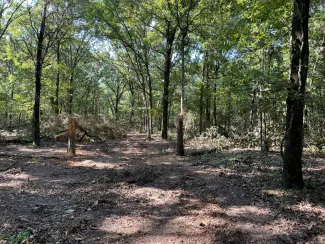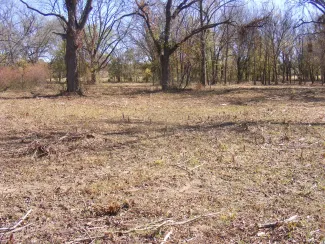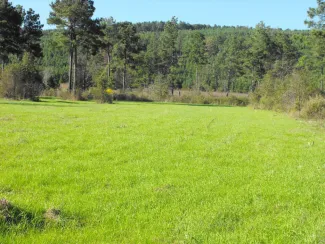Many practices are available to landowners looking to enhance forest habitats for wildlife and, when it comes to deer and turkey, wildlife openings should not be overlooked.

Small wildlife openings can make a big difference within a forest community, especially for wild turkey, white-tailed deer and a host of other species. (Photo provided by RosaLee Walker)
A wildlife opening is a small-sized forest opening that allows sunlight to reach the forest floor promoting the growth of herbaceous vegetation. While larger may seem better, it is important to keep the wildlife openings small, usually ½ acre to 2 acres in size. However, they can vary in shape – circular, rectangular, serpentine, or linear. Choosing the location of a wildlife opening is another important consideration.

Photo by Kyle Johnson.
Depending on a landowner’s overall goals, wildlife openings are best planned for areas that are relatively flat. Cutting the opening to run east to west is also recommended to maximize the amount of sunlight within the opening. In areas with slight slopes, wildlife openings are best suited on south-facing slopes as they also receive more hours of direct sun exposure. Soil types should also be taken into consideration if the opening may eventually be planted to some type of food plot mix; however, newly created openings rarely require seeding. Forest soils, in general, are packed with dozens of native grass and wildflower seeds that simply require some sunlight to germinate and emerge.

Wildlife openings can make attractive food plots; however, newly created openings will naturally establish into healthy, diverse plant communities that attract deer, turkey, quail, pollinators and many other species. Photo by Kyle Johnson.
Overall, the increased plant diversity within a wildlife opening will increase wildlife diversity by providing habitat components that were lacking or nonexistent in the prior vegetational cover. Beneficial plants that typically respond to newly created wildlife openings include such important species as big bluestem, little bluestem, partridge pea, crotons, and native sunflowers. The indirect food benefits are also many, especially a much higher abundance of insects that wild turkeys, especially turkey poults, eagerly seek.
While deer and turkey may be at the top of the wish list for most landowners, many native wildlife species benefit from having multiple successional stages of tree and herbaceous growth including eastern cottontail, northern bobwhite, woodcock, and eastern bluebirds. However, there are some species that may not benefit as much from open areas – pileated woodpecker, some neotropical songbirds, and amphibians among them. Yet if the openings are kept at the recommended size limit the negative affect on these animals can be minimized.
Of course, any new forest opening will require some tree removal or timber management. The two main types of timber management are mechanical (dozer, bobcat, chainsaw) or chemical (hack and squirt, spraying). Each one will have its challenges and the type and method will depend heavily on the landowner’s main objectives, access feasibility, and financials. It’s always recommended to consult a wildlife biologist or state forester to get a comprehensive wildlife or forest management plan ahead of any wildlife opening project.